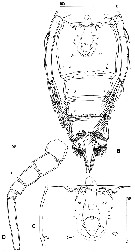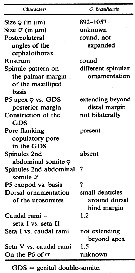|
|
 |
|
Harpacticoida ( Order ) |
|
|
|
Clytemnestridae ( Family ) |
|
|
|
Goniopsyllus ( Genus ) |
|
|
| |
Goniopsyllus brasiliensis Huys & Conroy-Dalton, 2000 (F) | |
| | | | | | | Syn.: | ? Clytemnestra rostrata : Ramirez, 1966 (p.291, figs.); ? Berasategui & al., 2005 (p.485, tab.1) | | | | Ref.: | | | Huys & Conroy-Dalton, 2000 (p.42, figs.F, Rem.); Boxshall & Halsey, 2004 (p.278) |  issued from : Huys and Conroy-Dalton in Bull. nat. Mus. Lond., 2000, 66 (1). [p.43, Fig.29]. Female from Rio Grande do Sul, Brazil): A, habitus (dorsal); B, anal somite and caudal rami (dorsal); C, caudal ramus (lateral); D, Md and Mx1; E, Mxp (posterior); F, distal portion of basis and endopod of Mxp (anterior). Scale bars in micrometers. Nota: Posterolateral angles of cephalothorax rounded, virtually not expanded laterally. Rostrum rounded (less pronounced than in G. clausi). Backwardly produced alate processes of somites bearing P2-P4 distinctly shorter and less pointed than in G. clausi.
|
 issued from : Huys and Conroy-Dalton in Bull. nat. Mus. Lond., 2000, 66 (1). [p.41, Fig.28, B-D]. Female: B, urosome (ventral); C, genital field (ventral); D, A1 (armature omitted). Scale bars in micrometers. A1 6-segmented; segment 2 shorter than in G. clausi but armature pattern identical. P5 markedly longer than in G. clausi, extending beyond distal margin of genital double-somite. Genital field as in G. clausi but with additional pores flanking copulatory pore.
|
 Issued from : K.H. Cho, W.-S. Kim & W. Lee in Proc. Biol. Soc. Washigton, 2010, 123 (2). [p.134, Table 1]. Diagnostic charateristics. Nota: Compare with G. clausi, G. rostratus, G. dokdoensis.
| | | | | NZ: | 1 | | |
|
Distribution map of Goniopsyllus brasiliensis by geographical zones
|
| | | | Loc: | | | SW Atlantic Ocean : Brazil (Rio Grande do Sul), ? Argentina (Mar del Plata).
Type locality: 32°11' S, 52°7' W. | | | | N: | 1 + 1? | | | | Lg.: | | | (931) F: 0,892-1,057; {F: 0,892-1,057} | | | | Rem.: | According to Huys & Conroy-Dalton (2000, p.42) many Sout-American authors have recorded specimens that they attribute to Clytemnestra rostrata, there is good reason to believe that in fact often they have mistaken G. brasiliensis for this species. Many of the Brazilian records of Clytemnestra rostrata are rendered doubtful. The same applies to records from Venezuelan coastal waters.
Identification characters after G.A. Boxshall & S.H. Halsey (2004, p.278):
1- Exopod of P1 with 3 distal setal elements; female A1 6-segmented.
2- Longer of 2 outer proximal bipinnate setae on female caudal ramus just extending as far as distal margin of ramus. | | | Last update : 25/01/2016 | |
|
|
 Any use of this site for a publication will be mentioned with the following reference : Any use of this site for a publication will be mentioned with the following reference :
Razouls C., Desreumaux N., Kouwenberg J. and de Bovée F., 2005-2025. - Biodiversity of Marine Planktonic Copepods (morphology, geographical distribution and biological data). Sorbonne University, CNRS. Available at http://copepodes.obs-banyuls.fr/en [Accessed January 02, 2026] © copyright 2005-2025 Sorbonne University, CNRS
|
|
 |
 |






